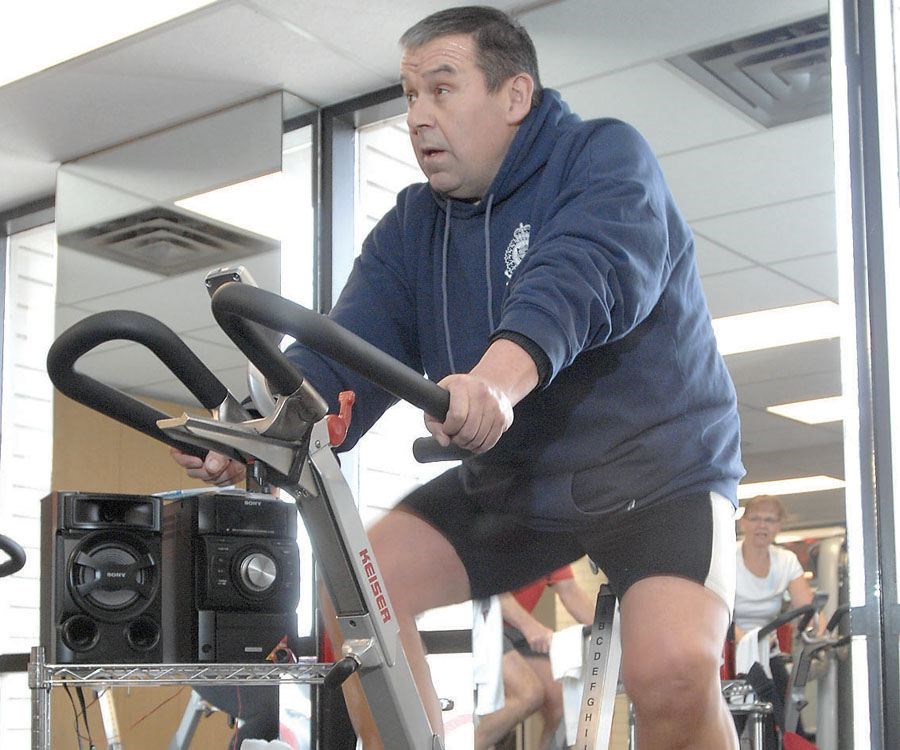Spin classes on an exercise bike are intense workouts, especially when retired Prince George RCMP officer Mike Stevenson is barking out the orders.
Stevenson, a veteran of four Cops for Cancer fundraising rides, brings drill-sergeant intensity to the noon-hour workouts at the YMCA of Northern B.C. in Prince George and as group leader he gains the same physical benefits as each of the panting, sweat-soaked participants in his class.
While spin classes are challenging tests of individual fitness, technology has the potential to turn that activity into a team event, and Y regular Chris Sitter has seen online what the latest gadgetry offers.
"It sends telemetry [from each exercise bike] back to the instructor so he can put that up on a board and make the right side of the class compete against the left side," said Sitter. "That will tell the instructor who's working harder, who's traveling further. The class gets competitive and it works."
21st century electronic circuitry has made great strides in the fitness industry. Stationary bikes now utilize opposing magnets to create smooth quiet resistance with the touch of a button, replacing the old-school spring-loaded cranks and belts. Each bike provides feedback on cadence (revolutions per minute), power output, heart rate, distance traveled, and gear selected so riders don't have to guess if they are cranking their legs hard enough to maintain their instructor's desired pace. If Stevenson tells them to climb up the Hart Highway hill, that means flipping a lever into the gear range with the most resistance.
"I can tell these guys what RPM to be at and what gear to be in -- with the old bikes we couldn't tell what gear you were in, you just said 'pedal hard,'" said Stevenson. "It's just another thing in our arsenal we use to train, so you know where you're at and can see your improvement."
Mavis Bethune prefers working out with an instructor, but on days she can't get there, she knows from past workouts what's required to get through one of Stevenson's sessions and uses the digital display instrument on her bike to replicate it.
"I can make up my own class just by looking at the RPMs and the gears and that helps me stay honest," said Bethune. "If I was just doing it by guess, it probably wouldn't be as challenging."
Machines that start out as stair climbers for warm-up mode automatically switch to a running motion that's easy on the joints. They adjust to the length of each user's strides to make interval training more comfortable and more fun. Steppers and treadmills have touch screens attached to the handlebars so users can pick and choose what they watch to keep their minds occupied while their bodies burn off calories.
"I enjoy that, being able to watch the news while you work out, it takes your mind off the pain you're in," quipped Stevenson.
Advances in communications technology in elliptical trainers, bikes and treadmills allow users to plug in their phones and watch Internet movies while they work out. Quick-response (QR) codes on posters at free weight stations in the gym can be scanned into smart phones to provide links to videos that show the proper way to perform each exercise.
If spin classes are not your thing, stationary bikes can take you from the gym to a simulated world tour. With a TV screen hooked up to Google Maps Street View, you could be on Champs-lyses avenue in Paris wrapping up the Tour de France, or be cruising on cliffs of Slea Head in Ireland enjoying spectacular ocean views.
"For me, it's all about keeping up with the technology because it keeps my participants motivated," said Shannon Johnson, YMCA of Northern B.C.'s co-ordinator of fitness programs. "For us [as instructors] the use of technology allows us to engage and retain our members better and helps motivate them. You have to try to stay up on the trends."
A smart phone loaded with fitness-related apps can be transformed into pocket personal trainer. For runners, apps like RunKeeper use GPS technology to map out real-time progress on a prescribed route, show how close you are to running a four-minute mile and will track whether you're on pace to meet goals.
iTreadmill makes your phone a pedometer, keeping track of all the steps you take in a day, the distance traveled and your average speed. FitnessBuilder offers thousands of photos and videos to show how to do 200 gym workouts, workout timers for interval training, and fitness calculators that figure out your rate of metabolism, body mass index and target heart rates. Weight-conscious workout buffs have apps like Lose It on their phones which allows them to input everything they eat and how much they burn off through exercise so they know exactly what they're allowed to eat to keep from gaining on the scales.
"I track my calories on the phone and that lets me know if I'm eating too much or having too many glasses of red wine," said Stevenson.


